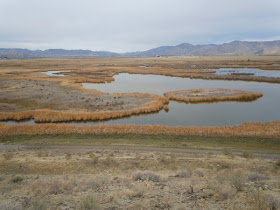 By Dayna Gross, Silver Creek Preserve manager
By Dayna Gross, Silver Creek Preserve managerOn June 23, Oregon State University held a farms and biodiversity tour in southcentral Idaho, including visits to Ernie’s Organic Farm near Shoshone and the showcase barley farm on the Stevenson property in the Silver Creek valley.
The stated purpose of the tour was to “see first-hand the progressive biodiversity enhancement practices that are driving sustainable agriculture forward in the 21st century and to interact directly with scientists, farmers and professionals who are helping us understand the role and importance of on-farm biodiversity for crop quality, yield and pesticide use reduction.”
We talked about a variety of farming practices and how they affect local biodiversity. Subjects included: integrated pest management, no till farming, cover crops, wetland protection, conservation easements, wildlife, restoration, native plants, beneficial insects and pollinators, soil, organic farming, water conservation, incentive programs for farmers, and the opportunities and constraints involved with all of the above.

We started the tour winding along the Little Wood River on Ernie’s Organics, a farm owned by Fred and Judy Bross, and then headed to the Stevenson property.
On both farms, the substantial riparian areas provide habitat for a variety of animals and the buffers along the agricultural fields are home to an abundance of beneficial insects and pollinators.
The biggest revelation of the day came to me as we looked for insects within the buffer zones on the Brossy property. Because of my background and experience, I have been thinking of landscapes primarily as wildlife corridors and water systems—but there are ecosystems within the landscape that are just as important.
For instance, the beetles that I collect with my sons (photo above) as we go for walks thrive in the native habitat along the road and move into the farm ground at night where they eat pests.
If buffer zones of native and flowering plants are close enough to crops, they reduce the need for herbicides and increase the resilience of the crop.
Similarly, pollinators are important for sustaining all kinds of natural systems as well as many of the crops we grow. I often promote riparian buffer zones as great wildlife habitat and important features for water quality and quantity (which they are). But they have been simultaneously providing important habitat for all kinds of little critters that make farming more productive, healthy, and sustainable.
Amazing what you learn when you start looking really, really, closely!
For more information on insects and their role in healthy farms and healthy habitat, contact Gwendolyne Ellen or the Xerces Society.

No comments:
Post a Comment